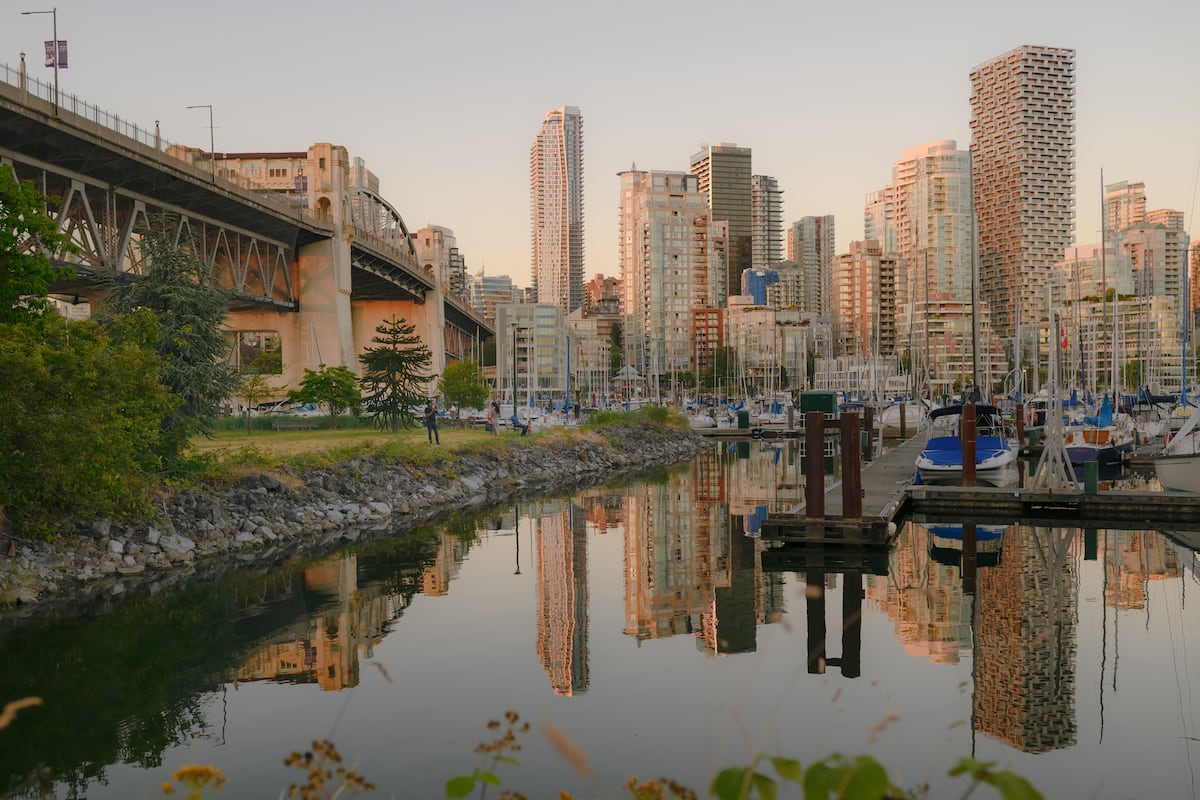An eternal presence on the Top Ten lists of cities with the best quality of life, Vancouver has everything that a modern urbanite could ask for: a dense and bustling downtown, notable gastronomic and cultural offerings, sweeping forests, mountains and easy access to the deep blue Pacific Ocean. To this attractive setting and ample array of services one might add economic stability due in large part to the city’s strategic position between Asia and North America. But paradoxically, and just as in many other great Western metropolises, Vancouver has been facing a serious housing shortage for years.
“Because Vancouver is so desirable, it has turned into a mecca for foreign investment, and today, middle class and low-income people are unable to live in the city,” says Penny Gurstein, professor emeritus and former director of the University of British Columbia’s School of Community and Regional Planning. That story is nothing new when it comes to the current global scenario, but Vancouver’s statistics are particularly worrisome: a study on Canadian housing access conducted by the national bank RBC and published in April found that to afford a property in the city, one would need to pay out 106.4% of the average salary.
“The city has tried, to greater and lesser extents, to deal with this problem through collaborations with contractors. For example, requiring that 20% of new housing units be set aside for low-income people. But despite these kinds of decisions, there is still a big problem in terms of access,” says Gurstein. “In that sense, one of the most significant changes in the way that land is being developed is that First Nations, the Musqueam, the Squamish and Tsleil-Waututh, have been successful in negotiating with the government for the return of their lands, and are now planning to use them for urban development.”
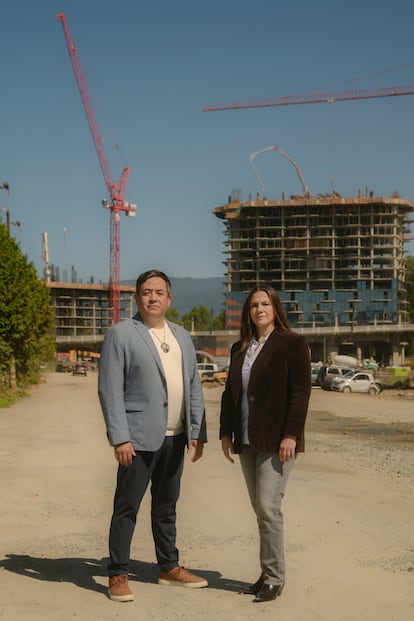 Wilson Williams and Mindy Wight, members of the Squamish tribe.Jennilee Marigomen (Contacto)
Wilson Williams and Mindy Wight, members of the Squamish tribe.Jennilee Marigomen (Contacto)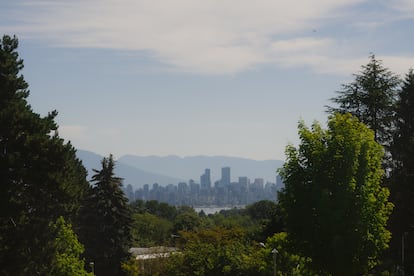 The city as seen from Jericho Lands, a project that is under construction.
The city as seen from Jericho Lands, a project that is under construction.
Jennilee Marigomen (Contacto)
Historically marginalized and excluded from the decision-making of the power structures, Vancouver’s Indigenous population — despite representing little more than 2% of its population — makes up 39% of its houseless individuals. But the script is being flipped on that precarity. Tribes are emerging as key actors when it comes to land use, are proposing new models for utilization and are guiding, on their own terms, reconciliation with the Canadian people.
The land return to which Gurstein refers is a process by which Canadian First Nations are becoming able, through lengthy legal battles, to get federal and regional governments to give back some of the territories that were taken from them by Europeans. “Officially taking back some of these lands that were illegally stolen from us was, in a way, something to celebrate,” says Wilson Williams, general councilor spokesperson for the Squamish Nation. “For our elders, though, it was a bittersweet moment. Our original territory was over 79 acres, and they only gave us back a little over 10. It was hard, but when they gave it back, we knew that it was a diamond in the rough, an economic engine for our people to achieve the financial independence for which we’ve been fighting.”
The territory that the Squamish Nation recovered in 2003 was initially an empty piece of land by the Burrard Bridge, which connects the skyscraper-heavy downtown Vancouver with the picturesque beachside neighborhood of Kitsilano. The nearly 12 acres of former railroad property that settlers expropriated from the Squamish between 1886 and 1913 were once, as Williams recalls, a summer vacation destination known as Senakw. “And not just a seasonal village,” he points out. “In Senakw, we had two or three chiefs residing year-round, meaning there were families living there. During the spring and summer, because of the abundance of resources, whether it was from hunting or fishing, they had a lot of food. It was always a meeting place, a place of cultural exchange where other communities and Indigenous nations came, due to intermarriage and trade.”
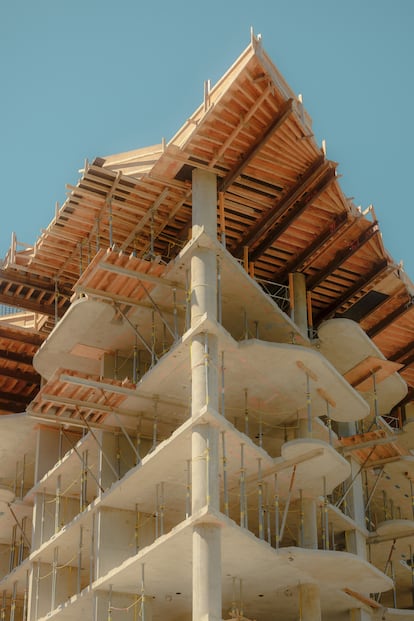 One of Senakw’s new ‘mountain towers.’Jennilee Marigomen (Contacto)
One of Senakw’s new ‘mountain towers.’Jennilee Marigomen (Contacto)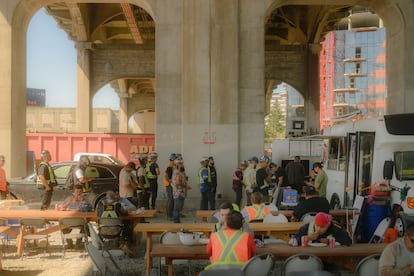 Workers on a break at the Senakw construction site.Jennilee Marigomen (Contacto)
Workers on a break at the Senakw construction site.Jennilee Marigomen (Contacto)
Upon the lands of this diamond in the rough, an urban development project is now underway, christened with the name of the original territory. The new Senakw will soon be comprised of 11 towers of up to 58 stories high with 6,000 rental housing units, 1,200 of them reserved for low-income people, including 250 for members of the Squamish Nation. Williams says that the intention behind building rental-only residential buildings is to “alleviate the housing crisis.” “With this project, we are creating four to five times more social housing than the city of Vancouver does in a year. And the leases will be for 99 years. This way, we guarantee people affiliation. We see it as a marriage. We offer tenants some security and continuity over time,” he says.
Construction on the towers began in 2022 and they are estimated to be completed in 2030, but beginning early this summer, the skeleton of three immense buildings could already be glimpsed while crossing the Burrard Bridge: the seed for what Mindy Wight hopes will be “prosperity for generations to come.” Wight is the executive director of Nch’kay Development Corporation, the organization that the Squamish Nation established in 2018 to manage its economic development, with the goal of keeping its business and politics separate. Serious and articulate, the Squamish woman left her job as a partner at a consulting firm to lead her tribe’s economic renaissance. Canadian magazine Maclean’s included her on its list of most powerful people this year.
In addition to Senakw, Nch’kay operates two marinas, an RV park and a gas station. “These businesses employ a large number of Squamish people and are very important to our functioning as a nation, and they will continue to be relevant as our real estate assets grow.” Wight is convinced that Senakw will lay the foundation for a future, profitable line of businesses. “Given the location of the Squamish people, population growth projections and the housing crisis, we see real estate development as a natural evolution for us.” According to its forecasts, Senakw alone will generate up to $9.4 billion.
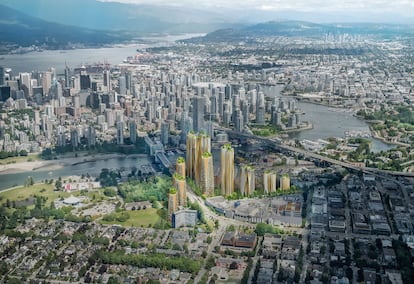 Digital recreation of the future 11 Senakw towers.Revery Architecture (Squamish Na
Digital recreation of the future 11 Senakw towers.Revery Architecture (Squamish Na Vancouver skyline as seen from one of the under-construction Senakw towers.Jennilee Marigomen (Contacto)
Vancouver skyline as seen from one of the under-construction Senakw towers.Jennilee Marigomen (Contacto)
For the development of Senakw, Nch’kay needed a partner who could guarantee them access to creditors and the expertise necessary to build, finance and market the project. They found it in Westbank, a real estate developer known for its numerous high-rise developments in Vancouver that is somewhat controversial due to its role in having built luxury housing for the foreign market. Wight says the developer and the Squamish collaborate “in areas such as design and recruitment, ensuring opportunities for member-owned businesses, employment and training.” And, she says, “at present, most of the workers on-site are Indigenous.” The federal government contributed the third element necessary for the project to go ahead, by providing the nation with a low-interest loan of $1.02 billion.
Williams and Wight insist that, past the economic impact they anticipate Senakw having for the Squamish, one of the main goals of their development project is to tell the story of their people. That’s why they created a cultural advisory council made up of representatives from Nch’kay, Westbank and the Squamish Nation, to ensure that their culture and art are appropriately reflected in the urban space’s design. Leading that council is Jacob Lewis, a Squamish member who is the manager of Senakw’s operations department. Lewis stresses the importance of decolonizing processes and ways of working, of Squamishizing the project. In addition to dealing with aesthetics, the council’s work also considers the site’s language. “There’s going to be a lot of linguistic integration in the project, both in situ and in our terms of references, our policies and processes.”
Another player in this Squamishification is Revery studio architect Venelin Kokalov, who, after numerous meetings with the cultural advisory board and Squamish artists, designed two typologies of buildings for Senakw: the “mountain towers”, with organic shapes and balconies inspired by Salish art, and the towers based on traditional Squamish communal houses, which feature balconies in the shape of salmon, a fundamental component of the tribe’s traditional diet. Kokalov recalls presenting as many as 10 different types of facades. “It was an interesting learning curve for us. Every time we drew something thinking we understood the cultural context, we were told no, that what we had depicted was not Squamish enough.”
Despite these good intentions, enormous historical significance and buoyant financial projections, Senakw has accumulated its fair share of detractors. The primary and loudest of these are those physically closest to the project, residents of the adjacent Kitsilano neighborhood. As the development is being built on sovereign First Nations-owned land — a reserve, as such land is called in Canada — it is not under the scope of the city’s zoning regulations. Kitsilano, an affluent, rather trendy and not particularly diverse neighborhood, lies in an area dominated by single-family homes, some of them historic and most of them low-rise.
One of these neighbors is Jeremy Braude, who came to Canada in the 1970s and has lived in Kitsilano for 26 years, all of them in a single-family home that stands a few feet from the boundary of the Senakw development. Braude, who has led some of the campaigns against Senakw, says he sympathizes with the idea that the Squamish should be able to develop the lands that belong to them historically, and that he agrees that the city is in desperate need of more affordable housing. Nonetheless, he’s concerned that the Kitsilano infrastructure isn’t prepared for the abrupt increase in population. “This project is eight times denser than the densest part of Vancouver. We are talking about 9,000 people in a very small area. An area that densely populated can’t be good for Vancouver nor for the residents of Kitsilano. We’re not Hong Kong. We don’t want to be Hong Kong.”
 Jeremy Braude, a Kitsilano resident.Jennilee Marigomen (Contacto)
Jeremy Braude, a Kitsilano resident.Jennilee Marigomen (Contacto)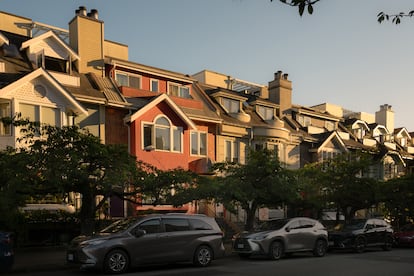 Typical homes of the neighborhood.Jennilee Marigomen (Contacto)
Typical homes of the neighborhood.Jennilee Marigomen (Contacto)
Braude also criticizes the lack of transparency in the contracts that were signed by the Squamish Nation and the city government, who conducted closed-door negotiations without consulting neighbors about the public services that the city would provide to the new development. Those points were also raised by the Kits Point Residents Association, a Kitsilano group to which Braude belongs, in the complaint it filed against the City of Vancouver and the Squamish Nation in October 2022. The court dismissed the lawsuit, finding the service agreement and the City Council’s resolution to adopt it to be valid.
Gurstein also recognizes the positive aspects of the Squamish Nation’s recuperation of its lands, but she also is in disagreement with the construction of the skyscrapers, which she says do not favor community building. She is also bothered by the fact that the Senakw was approved without public consultation and underlines that “what has really made Vancouver such a special city is that it has always consulted with citizens about how they wanted their communities to be.”
Senakw is the only urbanist Indigenous project of this size that is being solely developed on a reserve, but it is not the only macro-project headed up by a First Nation in Vancouver. Ten years ago, the Musqueam, Squamish and Tsleil-Waututh nations joined in what they called the MST Partnership, through which they have since negotiated with the federal and provincial governments over acquisition of lands. The governments give them priority of purchase as part of the reconciliation process between Canada and the sovereign nations.
Jen Thomas, head of the Tsleil-Waututh Nation, says that MST is the current owner of six large plots and is in the process of procuring another 19. On those lands, the tribes are developing urban projects similar to Senakw: tall, dense, controversial and unquestionably Indigenous. “MST Development Corporation [the organization created to manage the MST Partnership properties] is about to become the biggest real estate company on the West Coast,” says Thomas. “Some people in Canada continue to see the First Nations as if we were begging, right? Well, there’s no more need to beg. We will work in the construction industry to make our own money. It’s an economic opportunity to prosper and form a part of these projects, instead of remaining on the margins to watch them being built.”
It remains to be seen whether these dense First Nation housing complexes will alleviate the critical housing situation that is facing the city of Vancouver and to what point they will change the reality of the Musqueam, Squamish and Tsleil-Waututh peoples, not to mention historic power dynamics. But it’s impossible to deny the immense symbolic weight of the possibility that displaced First Nations might just find the solution to the housing problems created by their colonizers.
Sign up for our weekly newsletter to get more English-language news coverage from EL PAÍS USA Edition
